Content
- 1 Juicy peach variety
- 2 Varieties and their description
- 3 Self-fertilized, self-fertile peaches: Inka, Vulcan, Harnas, Golden Jubilee
- 4 What is the best peach variety to plant
- 5 Peach variety "Kiev early" (with description and photo)
- 6 Peach "White Swan": photo and description
- 7 Description of the peach "Ambassador of Peace"
- 8 Greensboro peach
- 9 Peach variety "Fluffy early": photo and description
- 10 Description and photo of the peach "Golden Jubilee"
- 11 Peach variety "Favorite Morettini"
- 12 Peach variety "Veteran" (with photo and description)
- 13 Peach variety "Redhaven": photo and description
- 14 Peach variety "Novoselovsky"
- 15 Photo and description of "Irganayskiy late" peach
- 16 Peach "Domestic" (with photo and description)
- 17 The best varieties of nectarine: photo and description
Peach is a short-lived plant... It is distinguished by its rapid entry into the fruiting phase, intensive growth.
Peach buds have the ability to quickly awaken and release young shoots. The crown grows and if it is not thinned out, starting from the second year, then the yield will decrease.
From the fourth year, the peaches will become small and misshapen. Young trees begin to bear fruit in the second year after planting. With good care, they can give a crop in the first year, with autumn planting.
But this should not be allowed. Better to let the plant develop. You will collect a small crop, but time will be spent, and the plant will lose strength.
Table of contents
- Juicy peach variety
- Varieties and their description
- Ripen early: Kiev Early, White Swan, Grisborough and Redhaven, Morettini
- Medium ripening: Collins, Cardinal, Golden Moscow, Sibiryak, Saturn, Kremlin, Donskoy
- Late, frost-resistant: Fury, Frost, Veteran
- Self-fertilized, self-fertile peaches: Inka, Vulcan, Harnas, Golden Jubilee
Juicy peach variety
In the past, gardeners dreamed of peaches that can be grown in all regions of the country, not just in the south.
Today, their dreams have come true: breeders have developed many interesting winter-hardy, frost-resistant varieties with different fruiting times, fruit shapes and taste.
Peach trees are divided into four groups (depending on the shape of the fetus):
- Real peach is a plant with pubescent fruits.
- Nectarine or bare peach.
- Potanin's Peach (Potanin's Almond).
- Fergana peach or fig (flattened fruit).
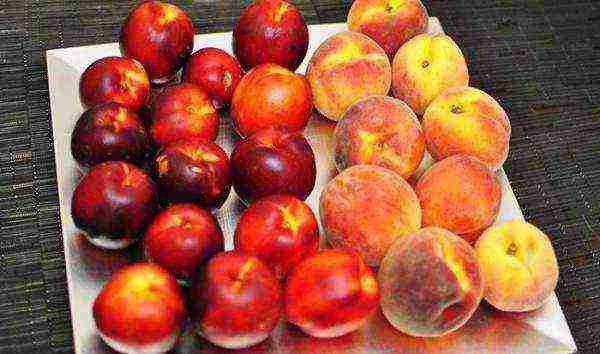 Peach trees are divided into four groups depending on the shape of the fruit.
Peach trees are divided into four groups depending on the shape of the fruit.
The timing of fruit ripening, the flowering period - it all depends not only on the area where the tree is grown, but also on the characteristics of the variety:
- Early maturing varieties give off the first fruits from July to August.
- Mid-season enter the fruiting phase in early August and delight with the harvest until September.
- Late peaches ripen in autumn: September, early October.
Which variety is best suited for a plot or garden depends on the climatic features of the area. It is important to choose plants so as to stretch the fruiting season for the whole season.
The yield of a plant depends on the correct choice of the variety. When buying a seedling, you need to pay attention to several important points, we give their description:
- Where did the seedling come from?... If the nursery is located in a different strip, then the seedling may die in the first year after planting or it will constantly freeze. The variety should be zoned, and the nursery should be in the same climatic zone (preferably even in the same region) where the tree will grow.
- Inspection of the scion site... It should be smooth and even, without bumps and hardened juice.
- Plant root system should have a fibrous shape. A root in one trunk is not good.
Annual seedlings take root better and delight with the harvest faster. When buying, it is better to focus on them, but choose strong, healthy plants, and not frail twigs.
Varieties and their description
Ripen early: Kiev Early, White Swan, Grisborough and Redhaven, Morettini
The peculiarity of early maturing varieties is that they quickly enter the fruiting phase. Two-, three-year-old seedlings are already producing a small harvest. Yields peak in the fourth to fifth year after planting.
When choosing early maturing varieties, it is better to focus on plants that have a low, spreading crown. They are easier to care for and shape during the growth period. Shorter trees are also easier to harvest.
Among the representatives of this group, varieties deserve special attention Kiev Early, White Swan and Redhaven.
Redhiven's crop peaks at 11 years of age. More than one hundred kilograms of fruits are harvested from one tree.
 The best early varieties of peaches: Kievsky Early, White Swan, Grisboro and Redhaven, Morettini
The best early varieties of peaches: Kievsky Early, White Swan, Grisboro and Redhaven, Morettini
Each variety of early peach is good in its own way and has a lot of advantages.
Benefits of early peach varieties:
- form a wide crown no more than 5 meters high;
- plants bloom in April-May;
- they enter the fruiting phase quickly: in the fourth year after planting the seedling;
- fruiting is extended from July to August;
- it has a high yield, aromatic and tasty fruits.
The first fruits appear on a mature, well-formed tree. This cannot but affect the yield: from a six-year-old tree, with proper care, you can harvest up to 60 kilograms of peaches.
Another prominent representative of this group is Grisborough variety... It is distinguished by medium vigor, but, unlike the aforementioned varieties, it has an average winter hardiness.
In order for the plant to bear fruit in mid-latitudes, it must be planted in calm places.
High winter hardiness pleases peach moretini... One of its advantages is a spreading crown that is easy to shape.
Morettini fruits are among the first to ripen, but have average transportability. This prevents the fruit from being transported over long distances.
Medium ripening: Collins, Cardinal, Golden Moscow, Sibiryak, Saturn, Kremlin, Donskoy
Medium ripening varieties allow the peach conveyor to continue.
Feature of plants of this species:
- high, spreading crown (from 5 meters);
- high productivity;
- good winter hardiness;
- large fruits.
Mid-season peaches have a huge number of varieties, but among them there are several types that show themselves perfectly in any conditions and do not require special care: Collins, Cardinal, Golden Moscow, Siberian, Saturn, Kremlin.
Variety Cardinal famous for its huge fruits (from 140 g) and excellent taste. This is one of the most delicious types of peach. On the international tasting scale, he received five points. This is the highest mark.
The plant is resistant to diseases, but it is difficult to tolerate recurrent frosts. It is better to plant it in a calm place, not far from the wall of a house or fence, but away from water.
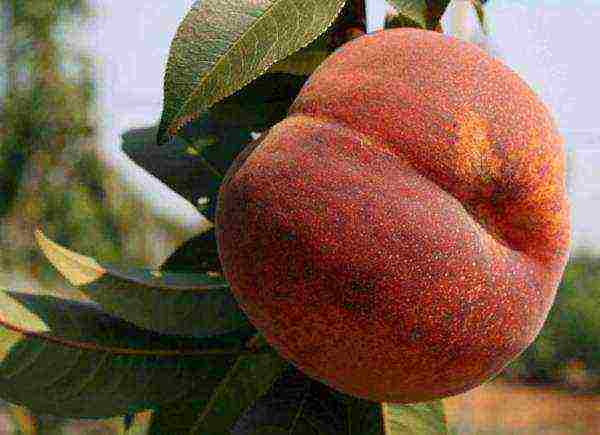 The best varieties of peaches of medium ripening: Collins, Cardinal, Zolotaya Moskva, Sibiryak, Saturn, Kremlevsky, Donskoy
The best varieties of peaches of medium ripening: Collins, Cardinal, Zolotaya Moskva, Sibiryak, Saturn, Kremlevsky, Donskoy
Kremlin peach adapts without problems to changes in temperature conditions, has high winter hardiness. Thanks to this, he attracted the attention of gardeners from regions where summers are cool. With good care, the fruits reach up to 200 g.
Variety Golden Moscow not so long ago appeared on the market, but its seedlings are very popular. The plant winters well and is resistant to diseases, has juicy large fruits.
The fruiting period stretches for almost three weeks. Peach blooms late, after the threat of frost return, and this increases the number of quality fruits.
Sibiryak variety highly regarded by farmers for its excellent transportability. The yellow fruit can be stored in a cold room for up to three weeks. In addition, they are tasty and juicy, and the bone is easily separated from the pulp.
The first crop is harvested in August, and the last fruits are removed in early September.
Peach Saturn stored no longer than 12 days. It's also a lot. The plant has high winter hardiness (up to -27). A strong crown complicates care and this affects the yield.
If the branches are tilted downward, then you can get an excellent harvest every year.
The most winter-hardy representative of this group is peach donskoy... It not only withstands severe frosts, but also quickly recovers after freezing.
The main advantage of peaches of the middle ripening period is high yield, transportability of fruits and excellent winter hardiness of the tree.
Most varieties have a juicy pulp and a pleasant aroma.... A high crown can be regarded as a disadvantage, but with the correct shaping of the tree, it is easily eliminated and turns into a virtue.
Late, frost-resistant: Fury, Frost, Veteran
Planted a peach, but it does not bear fruit, only intensively increases the crown? Do not be upset: it is better to be patient and wait a little longer.
Late-ripening varieties bear fruit starting at the age of 5 after planting a seedling. They are intended for cultivation in the southern regions. In the North and in the Middle zone, they do not have time to ripen and are sour.
American Fury withstands frosts down to -28 degrees. It is valued for its huge, up to 300 g, orange-colored fruits. The plant is undemanding to care.
The collection of fruits falls in September, when only apple and pear trees are left in the garden. The fruits are stored for no longer than six days.
Frost variety also bred by American breeders, who focused on winter hardiness and large-fruited plants.
The tree gives a high stable yield, withstands frosts down to -26 degrees, and is resistant to diseases. The fruits are used for fresh food. Stored for ten days.
 The best late-ripening peach varieties: Fury, Frost, Veteran
The best late-ripening peach varieties: Fury, Frost, Veteran
Veteran grade differs from late-ripening varieties in that it quickly enters the fruiting phase and has a low growth. The size of the fruit is also not impressive (no more than 150 g).
They love it for its good taste. It is ideal for conservation.
Self-fertilized, self-fertile peaches: Inka, Vulcan, Harnas, Golden Jubilee
Self-pollinated varieties are very popular among gardeners. To increase fruiting, it is recommended to plant several plants for cross-pollination... But one tree will also bear fruit.
Among self-pollinated, self-fertile varieties, a good harvest in a single planting gives Inka, Volcano, Harnas, Golden Jubilee.
Harnas belongs to winter-hardy, early-ripening dessert varieties. It is a vigorous tree that bears fruit regularly. Its peculiarity is that the fruits hold tightly to the branches and do not fall off.
Early maturing varieties are distinguished by high winter hardiness of trees and flower buds. They can withstand recurrent frosts. This makes it possible to grow them not only in the southern latitudes, but also in the middle lane, as well as in Siberia and the Urals.
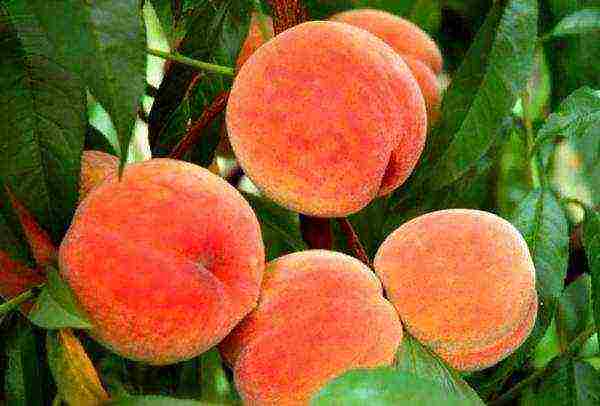 Self-pollinated peach varieties: Inka, Volcano, Harnas, Golden Jubilee
Self-pollinated peach varieties: Inka, Volcano, Harnas, Golden Jubilee
In the regions of Siberia, it is necessary to protect trees from recurrent frosts.
Mid-season varieties build up a decent crown and only then please with a rich harvest. The disadvantage is that it is difficult to form branches, but a regular and generous harvest allows you to turn a blind eye to this.
Mid-season varieties often bent downward to facilitate harvesting.
The lack of late-ripening varieties isthat they can only grow in a certain area. But if climatic conditions allow, then these trees will not only decorate the garden, but also delight you with delicious fruits.
When planting a peach, it should be borne in mind that all varieties bloom very early, when there are still few pollinating insects. You can help the plant by gently shaking the upper branches so that the pollen falls on the lower inflorescences.
Plants respond well to feeding and watering... Water plays an important role in the formation of fruits. Its quantity depends not only on the size of peaches, but also on their taste and aroma.
Give your seedlings a little attention and care so that they can turn into beautiful trees and please with the harvest every year.
Peaches come in many different types. They differ in taste, fruit color, type of cultivation, ripening time and many other indicators. Winter hardiness is one of the most important criteria for choosing a variety for growing in temperate and northern regions. Severe winters can completely destroy not only the future harvest, but also the tree itself, so scientists have bred several frost-resistant species. Winter-hardy varieties of peaches are not afraid of frost, and they will be discussed below in the article.
What is the peculiarity of winter-hardy varieties?
Winter-hardy peach varieties are able to withstand significant cold snaps. Even in middle and northern latitudes, they calmly endure wintering, but there are a number of important nuances that not all gardeners know about.
 The criterion for the winter hardiness of the tree itself and separately of the flower buds
The criterion for the winter hardiness of the tree itself and separately of the flower buds
- Each species has a certain criterion for the winter hardiness of the tree itself and separately of the flower buds. The index of frost resistance of a culture can reach up to -40 degrees, but flower buds can withstand, as a rule, a mark of -22 below zero, if we talk about winter-hardy varieties. So strong belated cold snaps in northern latitudes can still deprive the gardener of the harvest.
- Winter-hardy varieties must be properly cared for. If the tree is heavily overloaded with fruits, then winter hardiness will greatly decrease by the coming winter. Reduces this indicator and the age of the tree. The older it is, the less cold snaps it can withstand.
What are the most winter hardy peach varieties?
In northern and middle latitudes, winter hardiness plays a key role in crop selection. Previously, winter-hardy varieties of peaches did not exist at all, but many years of work by scientists allowed the northerners to grow a capricious culture.
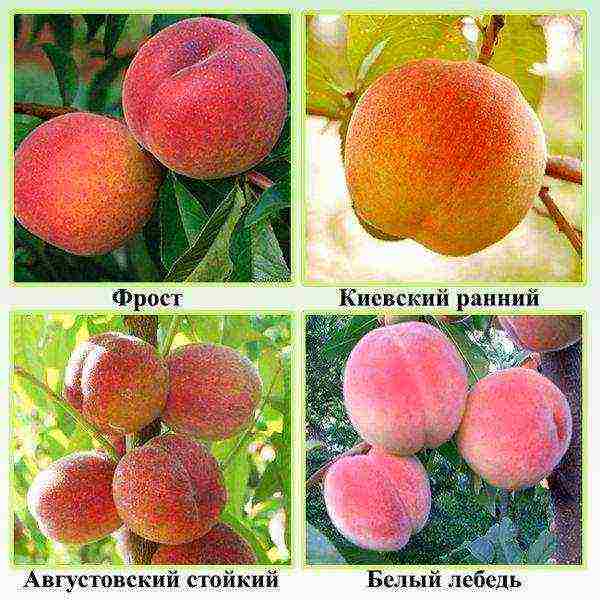 The most winter-hardy varieties of peaches
The most winter-hardy varieties of peaches
- "Winter hardy" - a unique variety grown in Ukraine from a simple seed and retaining all the qualities of the mother culture. The tree can withstand cold snaps down to -40 degrees, although in some cases buds, branches or even roots can freeze out, but the tree quickly recovers - in 1-2 years. The fruits are large - 200 grams or more. The harvest is very large, you have to cut off the extra ovaries in advance to make it easier for the plant, and so that the fruits obtained are very large and sweet. The disadvantage is that other types of peaches cannot be planted next to the tree.
- Frost withstands cold snaps up to -32 degrees. The ripening period is medium late - on the 20th of August. Fruits are yellow with a red blush over the entire surface, weighing 200 g or more. It is considered one of the most delicious in the whole world. The marketability and transportability of the product is high. Small trees, moderately resistant to powdery mildew and curliness.
- "Kiev early" tolerates frosts down to -32 degrees Celsius. But it is worth remembering that high resistance is possible only if the plant was not overloaded with fruits in the previous year and if it is a young culture. With a plentiful harvest, frost resistance decreases to -28 degrees.
- "August persistent" the peach variety is not afraid of frosts at -32 degrees. Moreover, the variety is resistant to many diseases. The yield is average, the fruits are small - 50 grams of creamy green color. The taste is a little sour, therefore it is more often used for processing, especially since the stone is separated from the fruit well.
- "White Swan" withstands a temperature drop down to -25.Spreading tree, fruits of 150-200 grams, dessert, very sweet. The skin is ruddy, the flesh is creamy. The White Swan variety of peaches bears fruit since mid-August.
Also, the frost-resistant varieties of peaches include "Donetsk white" and "Donetsk yellow", they are not afraid of frosts within -30 degrees Celsius. "Feichen-tao", withstands cold snaps up to -24 degrees. Of the overseas varieties, it is worth highlighting the "Harbinger", which is resistant to frost down to -20.5.
What winter-hardy varieties are distinguished by their yield?
Despite the winter hardiness of some peach varieties, if they do not give an abundance of crops, then there will be little sense from them, so many gardeners abandon the idea of planting a crop in cold climates. However, there are varieties that are not only resistant to frost, but also fruitful, their fruits are juicy and sweet - suitable for processing and fresh consumption.
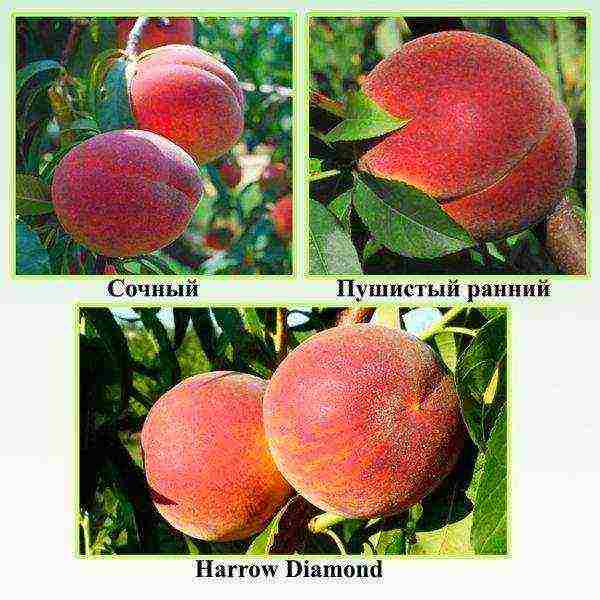 Winter-hardy peach varieties differing in yield
Winter-hardy peach varieties differing in yield
- "Juicy" - a variety of Eastern European selection. Withstands temperature drops down to -30 degrees Celsius, is not afraid of curliness and powdery mildew. It belongs to the early varieties. The yield is very high, so sometimes you have to pick off green fruits in order to lighten the "burden" of the branches.
- "Fluffy early" was bred by domestic breeders in 1932. It tolerates frosts down to -30 degrees. Tested by more than one generation of gardeners, now it is distributed throughout the territory of the former USSR. This variety is considered one of the best, cream-colored fruits are consumed fresh and processed. Ripens by mid-July. Spraying with fungicides is required from time to time. Productivity up to 100 kg per tree!
- Harrow Diamond - a kind of Canadian selection. Ripens from mid-July. Resistant to cold snaps down to -30 degrees and some diseases. Fruits up to 150 grams, transportable, usually with a red blush on the side. The taste is sweet and sour, the use is universal. The tree is fruitful.
The above-mentioned "Winter-hardy" and "Kievsky early" are also referred to the productive varieties, however, the higher their fruiting, the less resistance to frost. Therefore, experienced gardeners recommend picking off excess ovaries and fruits. This makes the branches lighter, leads to juiciness and sweetness of the fruits, increases their size, and also makes winter-hardy varieties of peaches more resistant to diseases and cold snaps.
The basis for obtaining a generous harvest of peaches is a competent choice of a place for a tree, a properly carried out planting process. When choosing peach varieties for planting in the Krasnodar Territory, you need to pay attention to the soil structure of your garden. Thus, if a clonal rootstock is used (in other words, a peach graft on a peach tree), then a soil with a carbonate content will not work. If your site has a close occurrence of groundwater, then planting peach trees will also not bring the desired result.
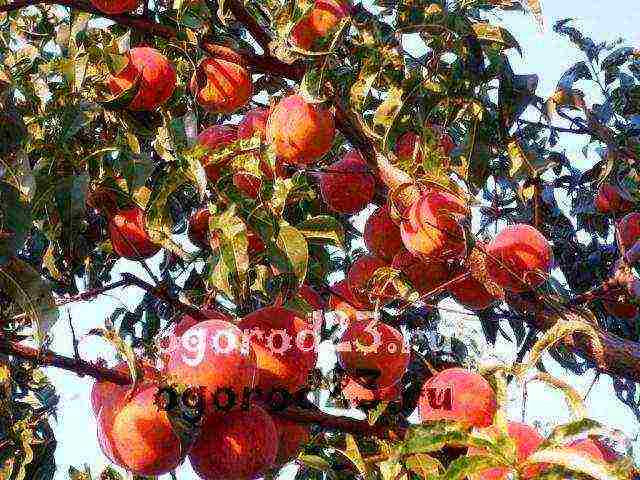
On sandy soil, as well as on dense loam, this culture will not feel comfortable. The optimal type of soil on which peach varieties successfully grow and bear fruit for the Kuban is structural soil. In the Krasnodar Territory, it is best to grow hardy cultivars. Young seedlings (annuals) are preferable to plant in a windless area, with the onset of autumn or spring, as soon as the snow melts.
Let's take a look at the best peach varieties that are ideal for growing in our region. Below will be described the main features of the species, their brief characteristics, possible disadvantages. We all strive to get the best result from the investment of our time and energy, so this choice should be taken seriously.
↑ back to table of contents ↑ Description of peach varieties
I'll start with the so-called fig varieties, all of which are domesticated. These varieties are bred by breeders and do not occur in the wild.Whatever they call them: Chinese turnip, Fergana peach, saucer, Chinese fig. Their fruits are low in calories along with nutritional value, and this applies to all representatives of this culture. To date, fig varieties of peaches have been bred: "New", "Saturn", "Turnip Stepnaya", "Vladimir", "Fig White". They are all distinguished by a characteristic, slightly flattened shape, a rich vitamin composition, and a pronounced sweet taste. However, there is also a minus - these fruits are very tender, not prone to long-term storage, quickly deteriorate (rot).
↑ back to contents ↑ Saturn
In the Krasnodar Territory, the Saturn fig peach is popular, it has a characteristic flat shape, very sweet in taste (without a sour note), the average fruit weight is 80-100 g. Very juicy, early-growing, frost-resistant, with a good yield variety. Fruits are yellow, with red barrels, frost-resistant, respond well to transportation. Inside there is a medium-sized bone, which is easily separated from the pulp.
Saturn, photo:
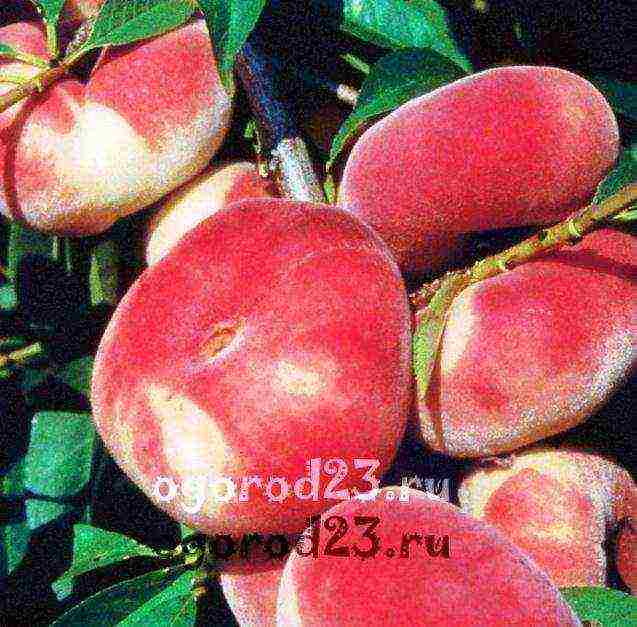
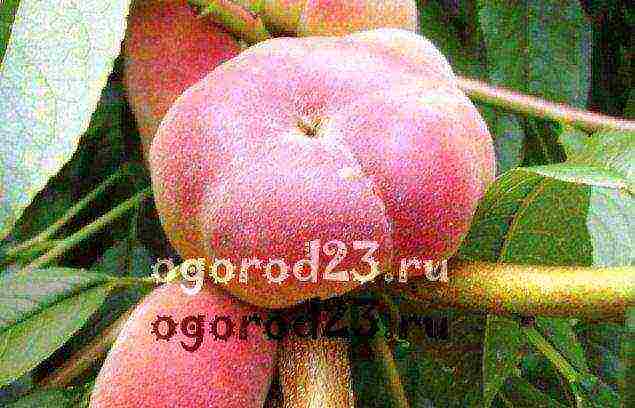
↑ Back to Contents ↑ Redhaven (Red Haven)
An excellent option for a summer residence: it ripens early, adapted for growing in our region. Fruits are medium and large, by weight can reach 130-150 g, are distinguished by high taste - this is one of the most delicious varieties. The color of the fruit is deep yellow, red fragments may be present, the pulp is yellow-orange in color, with a pronounced aroma.
Redhaven peach is an early variety with good immunity to many diseases, cold (frost). With improper care, it can become a target for fungi, requires an individual agrotechnical approach, timely fertilization.
Begins to bear fruit by the third year of life, ripens around the middle of summer. On average, 40-50 kg of peaches can be removed from a 10-year-old tree, which are well transported (dense pulp), well stored. It has a characteristic feature that is very convenient for those who grow crops for sale - an extended ripening period. There is such a thing as technical ripeness: a couple of weeks before the final ripening, the fruit takes on the appearance of an already ripe fruit.
Redhaven, photo:
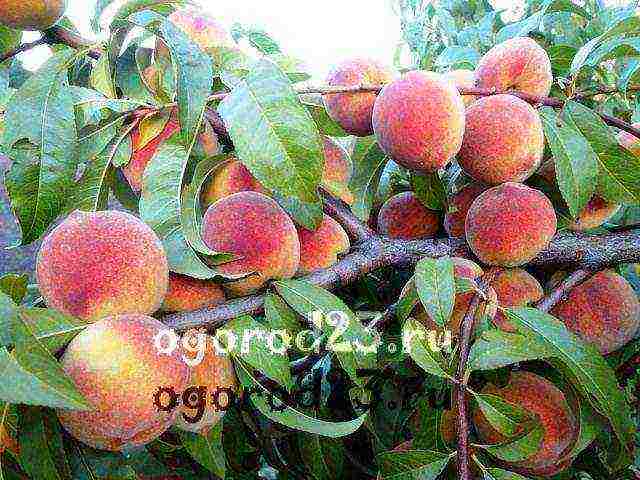
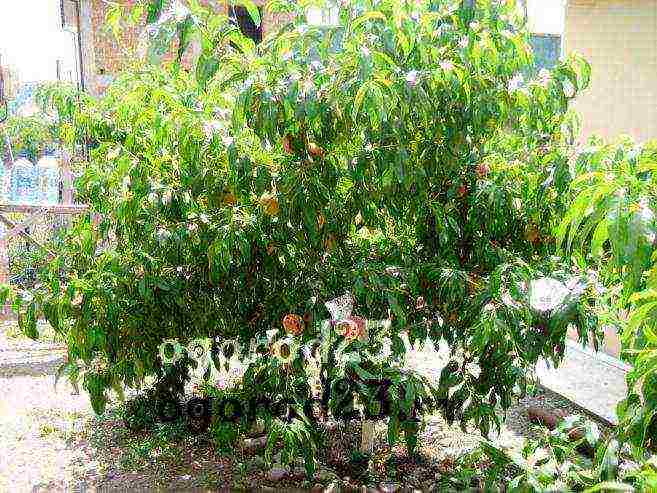
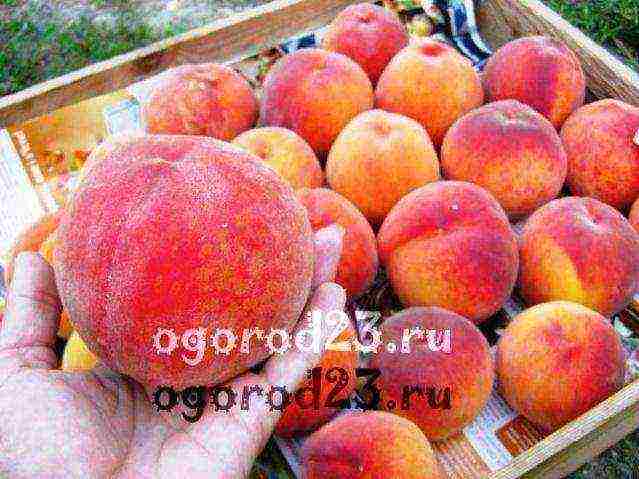
↑ back to contents ↑ Collins
This is a frost-resistant peach variety, spring and winter cold does not care for him. Differs in abundant productivity, when collecting fruits, you need to be vigilant - remove ripe fruits in time so that they do not break branches with their weight. Orange-red peaches do not ripen simultaneously, but in stages (sequentially), have a pronounced sweet taste with a slight admixture of sourness. This species is a find for lovers of large fruits, which can reach 150-160 g. The fruit itself can be round or slightly oval in shape, with a fluffy skin, which is rather difficult to remove.
Collins, cultivar peaches, photo:
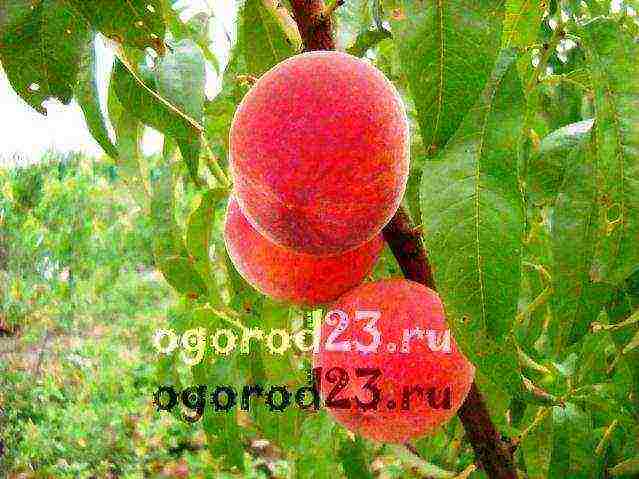
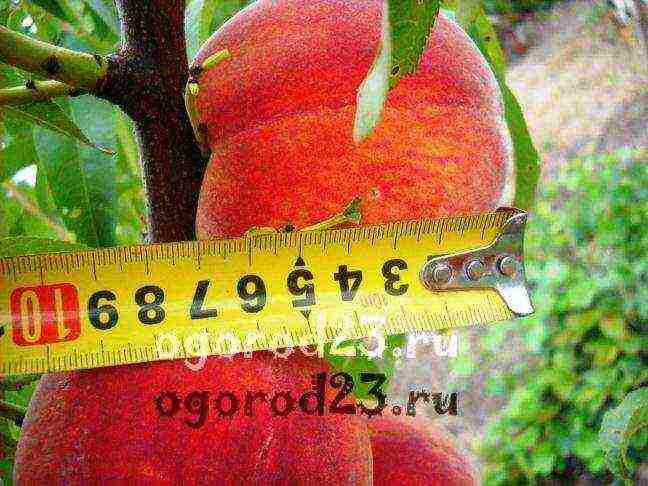
Collins' flesh is dense, with a bright characteristic aroma, the stone is small, it is easily separated (provided that the fruit is fully ripe). 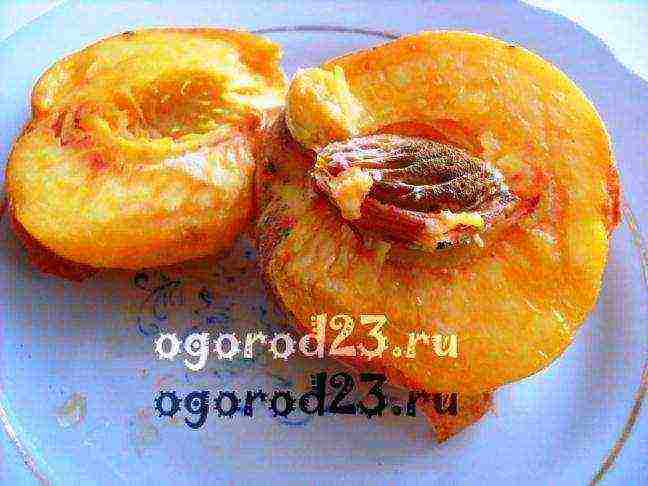 This species tolerates transportation well, ripens by the first days of July.
This species tolerates transportation well, ripens by the first days of July.
The tree requires maintenance (pruning branches, shaping the crown), regular watering and top dressing. You can hear different opinions about Collins from different gardeners: some have medium-sized, uneven fruits, and there are also references to cracking.
This species needs prophylaxis of the fungus clusterosporiosis (perforated spot). Collins also has a tendency to curly foliage, despite good resistance to other diseases.
↑ back to contents ↑ Memory of Semirenko
Peach variety Pamyat Semirenko meets all consumer requirements. It is a disease-resistant, mid-season (in the Krasnodar Territory it ripens by mid-July) high-yielding species with good winter hardiness. Fruits of a rich carmine color, round in shape, covered with edging, can reach 120 g.The pulp of the fruit is very sweet, fragrant, of a darkish yellow hue, the density is medium, which makes it difficult to separate the stone. Semirenko's memory has good disease resistance.
Memory of Semirenko, photo:
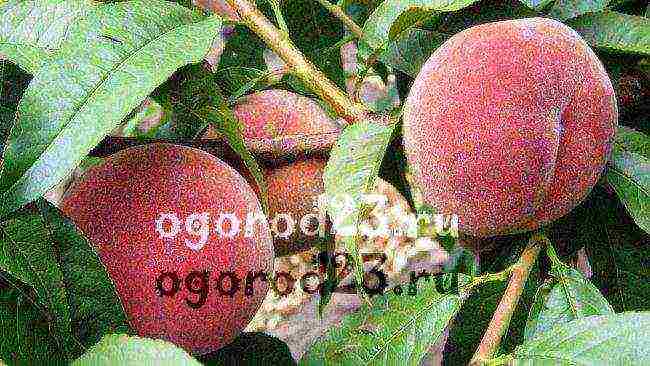
↑ back to contents ↑ Veteran
The Veteran peach variety is also a favorite among summer residents and gardeners. Medium-sized trees with a dense crown, the height does not exceed 4-5 meters. The fruits themselves are quite large (130-160 g), rich yellow color with a ruddy coating. The pulp of the fruit has an average density, a pronounced sweet with sour taste, a distinct peach aroma. The veteran is resistant to cold weather, bears fruit very well - about 50 kg of harvest can be harvested from an adult tree. The peak of the abundance of fruits occurs in the second half of August. Fruits are non-perishable, tolerate transportation well, are resistant to ash (powdery mildew), clusterosporiosis.
Veteran, photo:
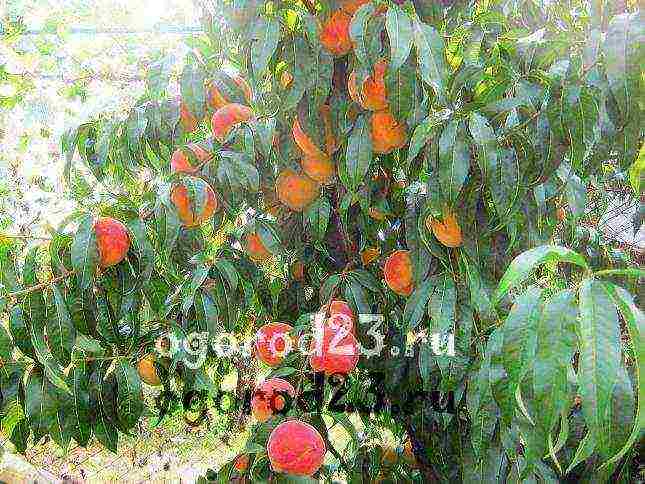
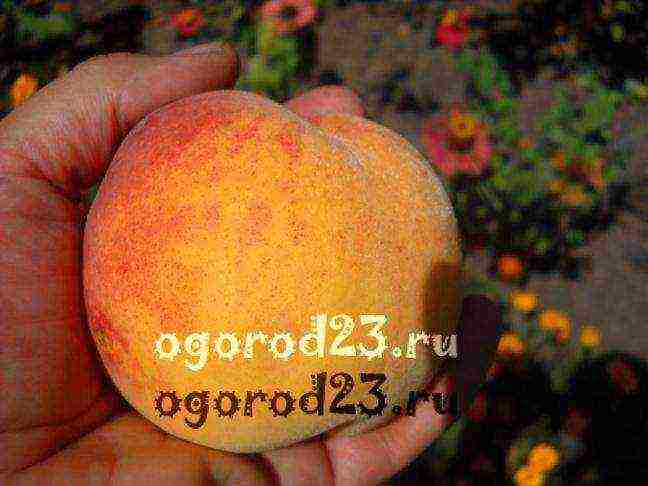
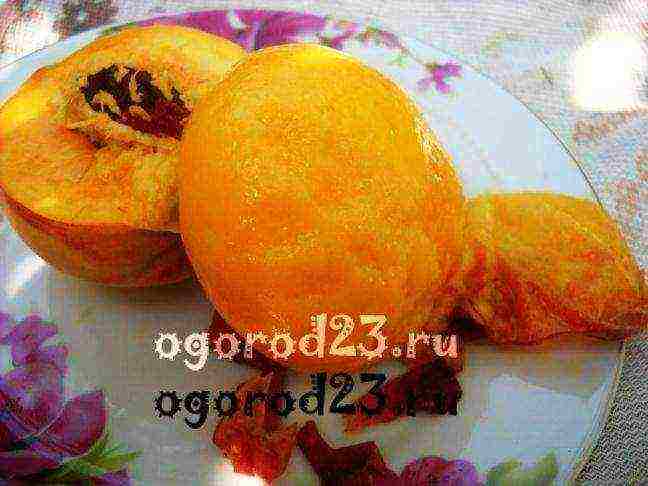
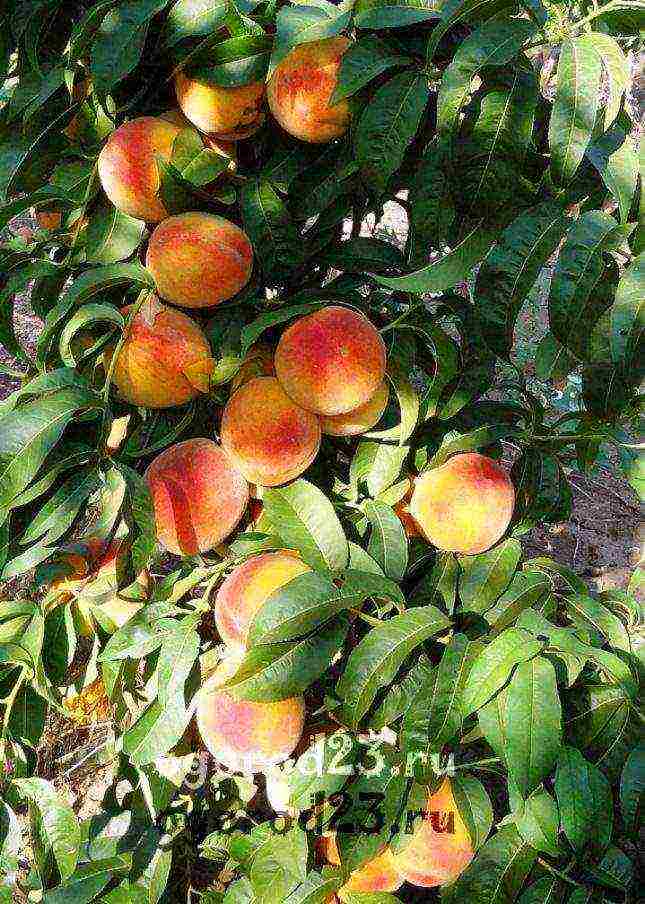
↑ Back to Contents ↑ Autumn Blush
Medium-late ripening peach variety Autumn Blush can produce fruits up to 200 g in weight. The fruit has a creamy shade with a red blush, a medium-term white pulp with a sweet and sour taste. These peaches are good both fresh and processed (compotes, jams, juices), they tolerate transportation very well. The pulp has a cartilaginous structure, the bone is not separated well.
Autumn Blush, photo:
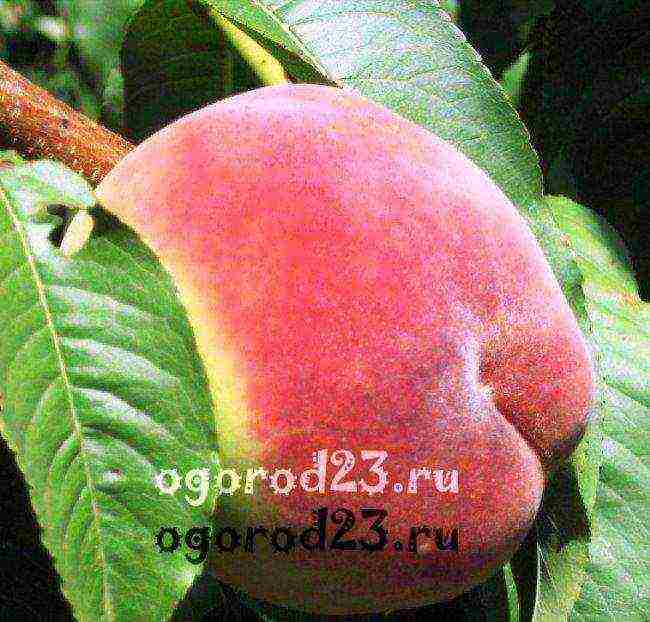
A bountiful harvest should be expected by late summer / early fall. Autumn Blush tolerates cold or drought well, has a strong immunity to the main diseases of this culture.
Through the labor of breeders, its clone, the Velvet Season variety, was bred. According to reviews on horticultural forums, the high yield of this species can contribute to the breaking of the branches. To avoid such a situation, ripe fruits should be removed from the tree in a timely manner.
It is the Autumn Blush, along with its "twin brother" Velvet Season, that provide the expansion of the range of peaches in the Krasnodar Territory. These varieties yield a harvest two weeks later than all the main types of the crop.
Velvet season, photo:
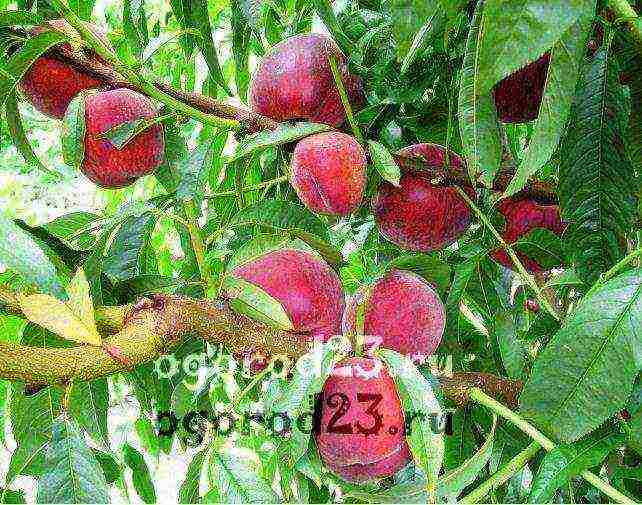
↑ Back to Contents ↑ Golden Jubilee
Peach Golden Jubilee - description of the variety: it ripens early enough (by the second half of August), gives a generous harvest (up to 50 kg per tree) and large fruits (150-180 g). The fruit itself has an oval shape, slightly flattened from the sides, golden color, with a rich carmine blush. It is a self-pollinated species, but experienced gardeners recommend planting the Golden Jubilee in small "families" to obtain an even larger yield. Growing nearby trees of the same variety will contribute to improved allogamy (cross-pollination).
Due to its adaptability to the climate of the growing region, the Golden Jubilee has become one of the most common, beloved peach varieties. The fruits removed from the tree have a long shelf life without losing their presentation (7-10 days), and are suitable for transportation. A small bone is hidden inside the fruit, which is easily separated from the pulp.
Golden Jubilee, photo:

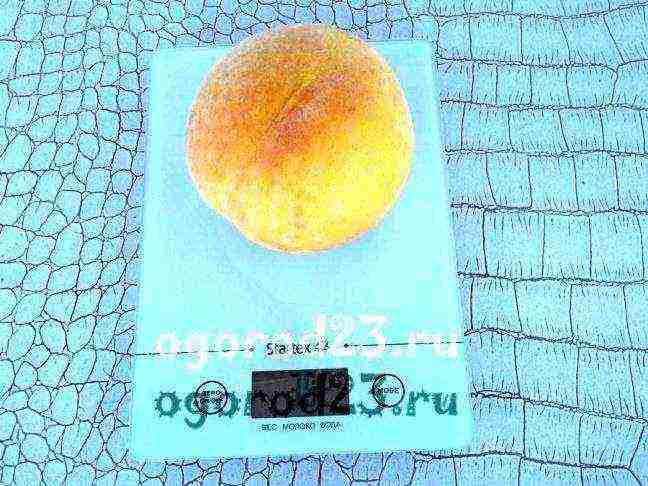
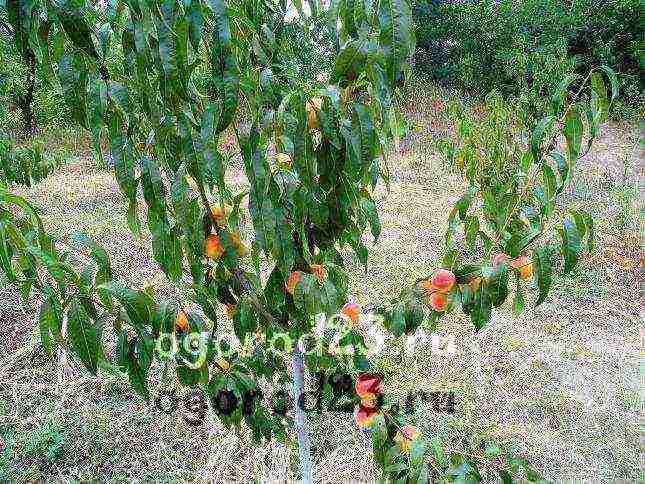
It has excellent taste characteristics - the taste is moderately sweet, with a slight bitterness. Frost resistance, high resistance to fungi and common diseases are the advantages of this type. The Golden Jubilee ripens by mid-July, but it is worth paying attention to its characteristic feature - the tendency to discard fruits, ripe and under-ripe. It makes excellent compotes, juices, jams.
↑ back to contents ↑ Early Kuban
If you are wondering which sort of peach is better to plant in our region, feel free to choose Early Kuban. This species has oval-shaped fruits, slightly pressed from the sides. Despite the small size of the fruit (80-100 g), the juicy tender pulp has a sweet taste and a pronounced aroma. Early Kuban is ideal for juicing and fresh consumption.
The fruits are slightly pubescent, covered with a beautiful golden skin with ruddy barrels, the stone is reluctantly separated, often cracking. This species is distinguished by an abundance of harvest, which ripens by the beginning of July. Indicators of winter hardiness, drought resistance, and disease resistance are average. Due to the very tender pulp, Early Kuban is not suitable for transportation, long-term storage.
Early Kuban, photo:

↑ Back to Contents ↑ Springold
Considering early peach varieties, you should definitely pay attention to the Springold variety. This is a very early species that allows you to taste sweet juicy fruits already in the first half of summer (mid / late June). The fruit has a slightly elongated shape, a pronounced golden-red hue, weighing on average 120-160 g. The fleshy core of the fruit pleases the eye with a bright yellow color and strong aroma, the stone is difficult to separate.
According to numerous reviews of gardeners, this is one of the most delicious peach varieties among the early ripe representatives of this culture. Tree growth is slightly above average, high yields and excellent disease resistance make Springold a clear favorite. For long-term transportation, this type is not designed, but for short-term it is quite suitable.
Springold, photo:

↑ back to contents ↑ Favorite of Morettini
Another representative of the early maturing species, bearing fruit by the end of June. Fruits of the Favorite Morettini are of medium size, oval in shape, weighing on average 80-100 g. The ripe fruit has a dark yellow color (with red blush and streak-like blotches), moderate edging, dense to the touch, but not too hard. The peach pulp is also yellow in color, juicy, sweet, with a pronounced aroma. A medium-sized bone from the pulp is difficult to separate, often cracking. Favorite Morettini is characterized by high taste and market indicators, very early ripening of the crop.
Favorite Morettini, photo: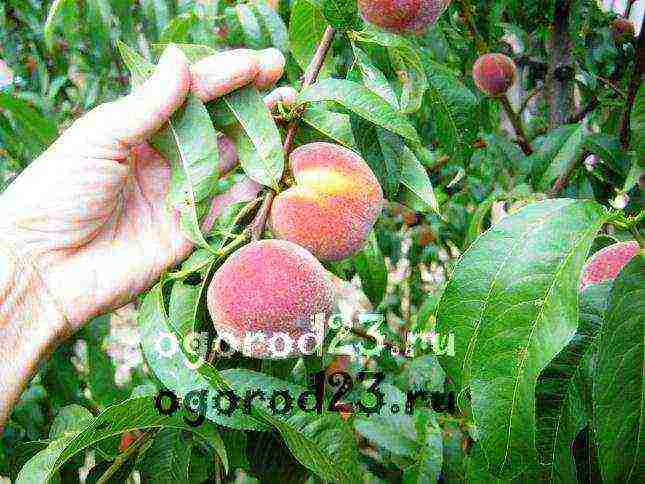
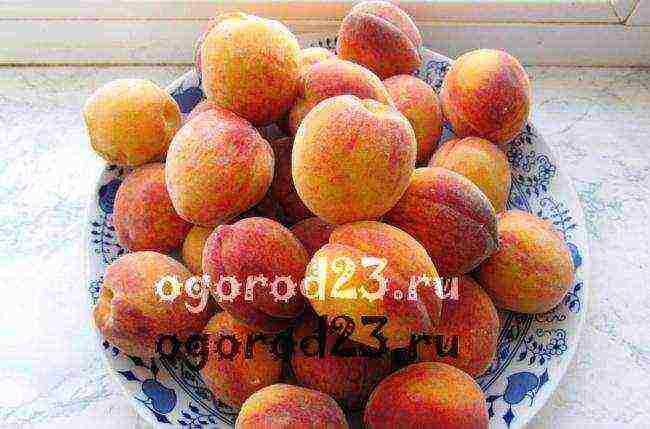
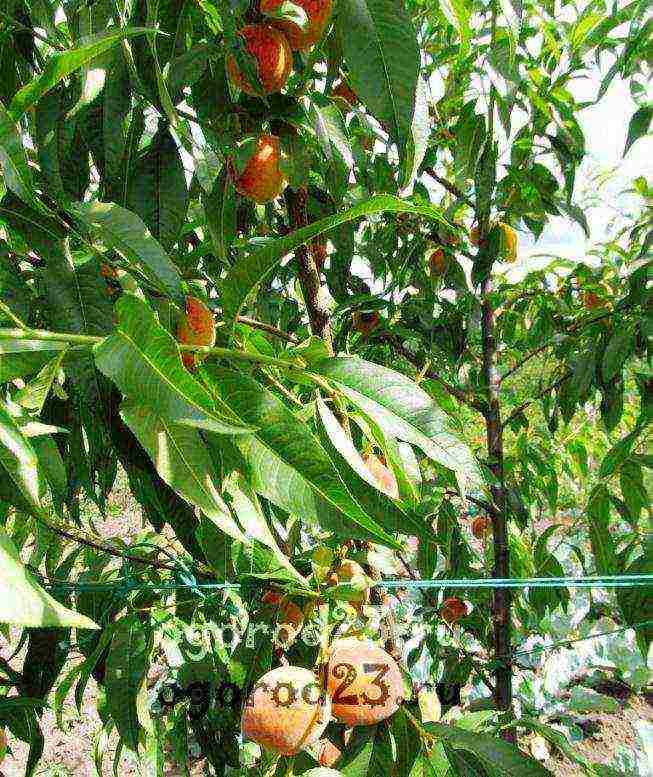
The trees of this species are of medium size - this factor significantly optimizes the process of harvesting fruits, facilitates the care of the plantings. Favorite Morettini begins to bear fruit in the second year of life, yields are usually generous and regular. The species itself is quite frost-resistant, the fruits, after being removed from the tree, do not deteriorate for three to four days. Possesses weak immunity against fungi, prone to moniliosis.
Summarizing all of the above, I would like to highlight the peach varieties that are the earliest, these are: "Early Kubani", "Favorite Morettini", "Collins", "Redhaven". Choose the highest quality, healthy seedlings, provide the tree with the necessary care. If you follow all the agrotechnical requirements for planting this crop, a bountiful harvest will not take long.
↑ to content ↑ Peach varieties resistant to curliness
The causative agent of this disease is a fungus that infects foliage with the arrival of summer. As a result, cuttings, internodes and shoots are deformed, foliage curls, changes color, the quality of the fruit is lost. In the advanced stage of the disease, leaves fall from the tree, branches die off. The fight against the disease consists in irrigating the crown with fungicides, which contain copper in their composition.
If you are thinking about planting young trees on your site, then pay attention to peach varieties that are resistant to curliness. Good immunity against this scourge are possessed by: Redhaven, Sunhaven, Springtime, Nectared 4, Stark Red Gold, Erlired, Saturn peach. According to gardeners' reviews on thematic forums, Early Kuban, Bagrinovsky, Madeleine Pouillet are also very resistant to curl.
Curly leaves, photo:
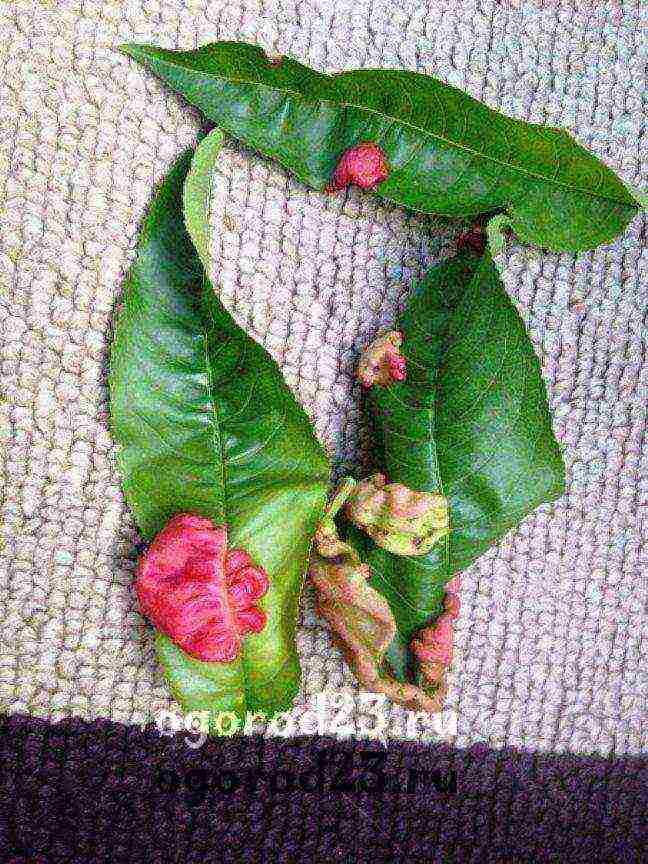
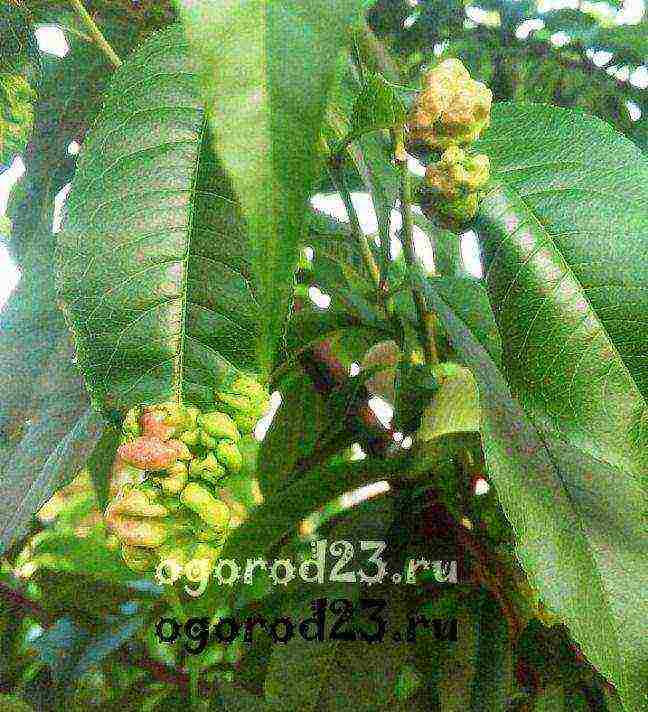
I also want to mention a couple of methods that are very effective, again, according to the recommendations of seasoned gardeners. The first "life hack" is the initial formation of a peach in the form of a bush, but not a tree. The second trick is to plant several tomato bushes under the tree (close to the trunk).You will hardly wait for a tomato harvest, but there will be no curliness - it has been checked repeatedly.
Summing up, it is worth mentioning that it is better to choose sunny and, if possible, calm places for planting peach trees. As an early flowering crop, it is preferable to plant them on the south side of the site. If you already have mature tall trees in your country house, place the peaches away from them (so that they do not shade the young trees). Low-lying or wetland areas with wet soil are not suitable for this crop. To avoid contamination of young seedlings with verticellosis, 4 years before planting peaches, do not plant watermelons, melons, pumpkins, strawberries, as well as alfalfa or clover in this place.
Before growing peach varieties in the Krasnodar Territory, prepare the soil properly: 12 months before planting, fertilize it with organic matter, mineral dressings. Do not forget about quality drainage for planting holes. Let, after all efforts, this beloved by many, fragrant, sweet fruit delight you with a bountiful harvest.
Peach is a fast-growing, short-lived culture, characterized by intensive growth and a rapid pace of passing through the age periods. The buds are early ripening, therefore, in young individuals from the wintering bud during the growing season, a branched system of shoots with lateral branches of the second and third order is formed. Along with this, it should be noted the high awakening ability of the buds and the shoot-producing ability, due to which the crown of 1-2-year-old trees is usually strongly thickened.
Not so long ago, the peach was considered an exceptionally thermophilic crop and could only be grown in southern regions with a mild climate. Modern varieties of peaches can withstand frosts down to -28C, which allows the plant to be planted in all latitudes. Flowering, fruiting and ripening of fruits directly depends on the variety (early, middle and late ripening), the climate of the area where the tree is grown, as well as on the growing conditions and care. The gardener should also remember that all varieties of fruits ripen in the greenhouse. For planting in open ground, you need to choose those of them, the fruits of which ripen during the growing season.
Trees with a fan-shaped crown are grown in greenhouse conditions. Each plant requires a 3/2 m area. The greenhouse should receive sunlight, in the summer at least half a day.
The varieties of early ripening include those whose fruits ripen in July-August. Middle and medium - late ripening varieties ripen in the third decade of August or early September. Late peaches are harvested in September-October.
What is the best peach variety to plant
When choosing which variety of peach to plant is best, you need to take into account that early-growing varieties begin to bear fruit 2-3 years after planting. High yields begin to be yielded in 4-5 years. Late fruits begin to bear fruit at 5-6 years. Many varieties are self-pollinated, but in order for a tree to bring a rich harvest, it is recommended to have 4-5 trees in the neighborhood, this will ensure cross-pollination.
In the peach culture, a large number of generative buds, ovaries are laid annually and, as a result, an abundance of fruits, but they can be small or poorly colored. To obtain high quality fruits, you need to regularly thin out the crown, which will provide good illumination. This work will help regulate the rate of fruiting. In the absence of pruning, trees age early, yields decrease.
The most common varieties are:
|
Alexander |
Amsden |
Greensboro |
|
Gavazuri |
Red-cheeked |
Success |
|
Elbert |
Champion |
Peach variety "Kiev early" (with description and photo)
In Russia, the peach variety "Kievskiy early", bred by crossing the peaches "Kashchenko 208" and "Gros Mignon", has won great popularity. It is a short tree or bush, reaching 4-5 m, which makes it quite convenient for harvesting.The crown is round, compact, of medium density.
Fruits weighing 60-100 g, round in shape with a pronounced abdominal seam. Skin tone ranges from light yellow to off-white with a slight blurred blush.
The pulp is white, without redness near the stone, juicy, firm, sweet, with barely noticeable sourness, pleasant to the taste. In a warm climate, fruits ripen on July 15-20. When describing the Kiev early peach, it should be noted that the winter hardiness of the tree and flower buds is high, so the variety can be grown in any latitude. The yield is high, about 60 kg of fruits are obtained from one tree. "Kievsky early" is resistant to powdery mildew, curly leaves and other diseases.
Peach "White Swan": photo and description
Peach "White Swan" is a medium-sized tree up to 6 m in height. Its crown is spreading, broadly oval. Fruits are round, large, weighing 150-200 g. The skin is intensely yellow, with a pink blush. The pulp is white-creamy, juicy, with a high sugar content, due to which the White Swan variety is considered a dessert. Fruit ripening occurs at the 20th of August. This peach is high-yielding, self-fertile. Withstands prolonged droughts. Increased frost resistance, tolerates temperatures up to - 25 ° C. Flower buds are not damaged by frost. The fruits are transportable. They are used fresh, and also go to the manufacture of compotes, juices, preserves, desserts.
Description of the peach "Ambassador of Peace"
Peach "Ambassador of Peace" - a tree of medium height, reaching 5-6 m, with a spherical spreading crown. Flower buds are laid on all types of shoots. The fruits are round, very attractive in appearance. Their mass is 180-220 g. The skin is yellow - carmine. The pulp is yellow, quite juicy, fibrous, and has a pleasant taste. The fruits ripen in the second half of August. "Ambassador of Peace" is frost-hardy, with high resistance to spring frosts. Self-fertile. Brings regular rich harvests. To prevent tree branches from breaking under the weight of the fruit, a normalizing annual pruning is required.
Greensboro peach
Greensboro peach introduced in America in 1981. It has many positive qualities that cover some of its shortcomings. It is a vigorous tree with a wide spreading crown. Annual shoots of medium length and thickness, smooth, burgundy, have short internodes. The flower buds are large, ovate, pointed from above. The leaves are thick, leathery, with the ends bent down, 16 cm long. The surface of the leaf plate is smooth, shiny, dark green, the lower part is greenish-gray. The flowers are large, with wide pale pink petals. The peduncle is short. Fruits are spherical, slightly elongated, weighing 100-120 g, with a blunt top and a small depression, which is a characteristic feature of the variety. The skin is coarsely pubescent, greenish-creamy, with a blush in the form of dots, occupying? part of the fruit.
The pulp is very juicy, fibrous, fragrant, the same shade as the peel. It tastes sweet and sour. The stone does not separate from the pulp, often cracks. Winter hardiness of the Greensboro variety is high. Its disadvantage is the poor transportability of the fruit.
Peach variety "Fluffy early": photo and description
Peach "Fluffy early" - a tree up to 5-6 m in height. The crown is broadly oval, slightly spreading. Fruits are elliptical with a rounded apex, in which there is a small depression, weighing 70-100 g. The peel is of medium density, with a weak ventral seam and tomentose, cream shade with a bright red blush. The pulp is loose, fibrous, tender, white, sweet taste. The "Fluffy Early" peach variety is valued for its good winter hardiness and annual, rich harvests. The disadvantages include satisfactory taste of the fruit.
Description and photo of the peach "Golden Jubilee"
Peach "Golden Jubilee" Is an American variety, bred in 1921.It is a medium-sized, fast-growing tree with a height of 4-5 m. Fruits are large, weighing 130-140 g, spherical, with a weakly expressed abdominal suture, deepening towards the base. There is a narrow, deep funnel at the top. The skin is dense, slightly pubescent, golden yellow with a dark red blush.
The pulp is juicy, non-fibrous, yellow-orange, on the palate sweet with sourness. The stone separates well from the pulp. Fruit ripening occurs in the second half of August. The description of the "Golden Jubilee" peach will be incomplete without mentioning its frost resistance and winter hardiness of flower buds. Fruiting occurs at the age of 3. Trees give annual, bountiful harvests (40-50 kg per bush). The fruits of this variety are transportable. Stored in storage for up to 8 days.
What the Golden Jubilee peach looks like can be seen in the photo below:
Peach variety "Favorite Morettini"
Peach "Favorite Morettini" - an early variety bred in Italy. Medium-sized tree with a spreading crown. Fruits are round-oval, small and medium, weighing 70-90 g, with a superficial ventral seam. The skin is dense, velvety pubescent, yellow, with a red dotted and streaky blush, which occupies most of the fruit. The top is pointed. The pulp is tender, fibrous, juicy, aromatic, sweet, with a good taste. The bone is not separated from the pulp. The fruits ripen in early July. Transportability is average. The shelf life is 3-4 days. The yield of this variety is average. Winter hardiness is high.
Peach variety "Veteran" (with photo and description)
The Veteran peach variety was bred in Canada. It is a weakly growing tree up to 4 m in height with a spherical thickened crown. Fruits are round in shape, weighing 130-180 g. The peel is yellow, with a pronounced blush, which occupies most of the fruit. The pulp is yellow, of medium density, juicy, aromatic, sweet, with sourness, good taste. Maturation occurs on August 10-15.
The description of the Veteran peach is in many ways similar to the description of other winter-hardy varieties of this culture. The yield of the tree is high. Up to 50 kg of fruits are obtained from one individual. This variety is distinguished by an abundance of flower buds, which ensures stable fruiting after harsh winters. The advantages of the Veteran peach include good keeping quality and transportability of the fruit. The tree is resistant to powdery mildew, clasterosporium disease.
Peach variety "Redhaven": photo and description
The Redhaven peach variety was bred in the USA in 1940. This is a short tree up to 5 m in height, with a wide-cone-shaped crown of medium density, up to 10 m wide. The bark of the branches is gray-brown, strongly cracking. Vegetative buds are small, conical. Generative - small, elongated to the top. The leaves are large, lanceolate, finely serrated along the edge, up to 17 cm long, up to 4 cm wide. The leaf blade is smooth, shiny, dark green. The flowers are bell-shaped, bright pink, of medium size.
Fruits are round or rounded-oval, weighing up to 140 g. The skin is dense, bright yellow, with a blurred red blush and delicate pubescence, easily removed from the fruit. There is a depression and a slight bulge at the top. The pulp is creamy, friable, fragrant, with a pleasant taste. The stone is easily separated from the pulp when the fruit is fully ripe. Ripening August 5-10.
Peach "Redhaven" (photo above) translated from English. means "red paradise". The variety received this name for the attractiveness and high taste of the fruit. Its advantages also include regular and abundant fruiting (from 50 to 100 kg of fruits from one bush), resistance to curly leaves. Redhaven is self-pollinated, but peaches of other varieties are planted in the neighborhood to increase yields. Due to the abundance of fruits, it is possible for them to shrink and overload the branches with the harvest.
Peach variety "Novoselovsky"
The Novoselovsky variety was bred by crossing one of the peach varieties with the Kievsky early. This is a dwarf tree up to 4 m in height. The crown is compact, rounded.Fruits weighing 50-70 g, round or round-oval, with a well-defined abdominal suture. The peel is pubescent, white-cream, with a blurred pink blush on the sunny side.
The pulp is greenish-white, tender, moderately sweet with sourness, satisfactory taste. The bone is fused with the pulp.
Ripening in the third decade of July. "Novoselovsky" is one of the most winter-hardy varieties, surpassing on this basis "Kievsky early" and some other frost-resistant varieties. However, the quality of the fruit is significantly inferior to the aforementioned peach.
Photo and description of "Irganayskiy late" peach
Irganayskiy late peach obtained by free pollination of the variety "Hadussamat yellow". The tree reaches 5-6 m in height. The crown is spreading, broadly oval. Shoots are straight and geniculate, green, red on the sunny side, slightly pubescent, with a few white lenticels. Each bud consists of two lateral generative and one vegetative. Generative buds are located on the lower and middle parts of the shoot. Leaves are broadly oval, elongated towards the base, shiny, dark green, flat, curved downward, serrate-crenate along the edge. The flowers are red, bell-shaped.
Fruits are round, weighing 120-160 g. The top is slightly depressed. The peel is yellow, with red spots, of medium thickness, easily removable.
The pulp is yellow-orange, non-fibrous, sweet. Ripens in late August - early September. Fruiting at 4-5 years of tree life. The variety is frost-hardy, generative buds are not damaged by spring frosts.
Peach "Domestic" (with photo and description)
Peach "Domestic" - a tree with a broadly oval crown, reaching up to 8 m in height.
Fruits are round-ovoid, slightly beveled, weighing 80-120 g. Creamy skin, with a bright raspberry or carmine blush, dense, with velvety pubescence. The pulp is white, friable, fleshy, moderately sweet with sourness. Variety "Domestic" early ripening.
Our gallery contains photos of peach varieties:
The best varieties of nectarine: photo and description
As you know, nectarine is a kind of peach, which differs from it with a smooth skin without pubescence, smaller fruit size and firmer pulp. A peach of the nectarine variety is more aromatic and tastier, but its pulp is not as juicy and loose as that of an ordinary peach.
Despite the huge variety of nectarine varieties, those that are stored longer and are better transported are popular. In addition, there are large-fruited varieties with a fruit weight of up to 200 g.
New winter-hardy varieties are quite promising and suitable for growing in a garden plot, such as:
|
Scythian |
Krasnodarets |
Favorite 1 |
|
Favorite 2 |
Fodor |
The best varieties of nectarine:
|
Autumn blush |
Rilines |
Abundant |
|
Pink princess |
Nectarine "Krasnodarets" - a tree reaching 4-6 m in height with a wide spreading crown. The flowers are pink, with oval pink petals. Fruits are small, elliptical, weighing up to 40 g. The peel is orange-yellow, with a dark red blush. Taste is average. The yield is high. Resistance to powdery mildew and klyasternosporiosis is average.
Nectarine "Skif" - a powerful, vigorous tree up to 10 m in height. The crown is wide-pyramidal. Fruits are round, weighing up to 120-180 g. The skin is yellow with a red blush. The bone is free. Ripens in mid-August. "Skif" is appreciated for its regular abundant yield, resistance of flower buds to frost and fruits of pleasant taste.
Lola nectarine - Uzbek variety. The trees are medium-sized, up to 5-6 m in height. The crown is broadly oval, slightly spreading. The flowers are pink-shaped. Fruits are broadly oval, weighing up to 100 g with a weakly pronounced abdominal suture. The skin is greenish-creamy with a dark red blush that occupies most of the fruit. The skin is of medium density and thickness, easily separating from the pulp. The pulp is white, fibrous, aromatic, sweet.The taste is satisfactory. The bone does not come off. Lola nectarine is self-fertile, early ripening. Increased winter hardiness.
You can see the varieties of nectarine and their external features in the photo below:
Having chosen a certain variety, you need to provide the plant with a sufficient amount of light. Landing sites must be protected from wind and drafts, located on high ground. You should not choose a low-lying area or a ravine for this culture, where cold air accumulates.
In terms of soils, the tree grows and bears fruit equally well on any drained nutrient soil. To create drainage, it is necessary to fill in a layer of gravel or brick chips at the bottom of the pit. Fertilizers are applied to poor soil a year before planting.
Today, peach breeding is practiced in many countries. It is noteworthy that this culture has gained immense popularity in recent years, displacing most other stone fruit crops. The most important tasks facing breeders are to increase winter hardiness, fruit transportability, and disease resistance.
The longevity of peach orchards is low, an average of 15-20 years. Under unfavorable conditions, it decreases to 10-12 years, under favorable conditions, it increases to 30-40 years. Some individuals are able to live up to 50 years.


